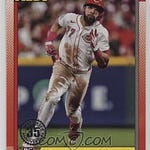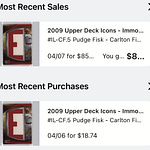Affiliate Disclosure: This post contains affiliate links. As I am a part of the eBay Partner Network and other programs, if you follow these links and make a purchase, I’ll receive commission (at no cost to you). I appreciate your support!
Disclosure: I also work closely with CollX, and this content may be disseminated via the CollX app at some point. That said, all opinions, examples, experiences are entirely my own, and not shaped by any third party input or guidance.
This is not buying or investment advice. I’m simply reporting the data I’m seeing. Please do your own research and make your own decisions. Just because cards have increased in value up to this point, it doesn’t mean they will continue to do so.
I learned something new about an overlooked 90s parallel that I’ve now added to my Sneaky Valuable Cards list—along with a few others I’ve uncovered lately. If you’re a paid subscriber, that list is live and updated.
The Flip: Fast, Simple, Profitable
I just made about $250 in profit on a single card—and it came together quickly. This wasn't some long-term play or rare auction win. I didn’t have to risk $100 (I bought it for $2.80 shipped).
I spotted an opportunity, acted fast, and had a profitable flip on my hands within a week. The best part? Along the way, I learned something new about an overlooked 90s parallel.
Learning Through Listings
I know a lot about cards, but I’m ALWAYS looking to learn more. One way is I spend a lot of time on eBay looking at sold listings—specifically for cards from 1994 through the early 2000s.
I check every day or two, filtering by recently sold items, and sorting by highest sale value. That’s how I came across a Kenny Lofton 1996 Leaf Signature Series Platinum Proof that sold for around $31 (confirmed via 130point.com).
Whenever a non-superstar card sells for that much, it sets off alarm bells in my head. We’re not talking Griffey, Bonds, or Rickey here. It’s Kenny Lofton. So I started digging into the set.
I found more Platinum Proofs from the same series—Mark Newfield selling for $20+, Darryl Strawberry for over $60. At that point, I started wondering what a bigger-name player might go for, and if there were any for sale…
The Find: $2 Chipper Jones
I jumped over to CollX and searched for “Platinum Proof.” There it was: a Chipper Jones Platinum Proof listed for $2.
I couldn’t find any previous Chipper comps. But it didn’t matter. That’s usually a good sign, anyway, as it is a great indicator that the card is rare or hasn’t hit the market much. I grabbed it immediately.
Research and Pricing Strategy
When the card arrived, I dug in deeper to get a better idea of pricing.
Using eBay’s Research Tool and filtering by highest sold prices, I saw a Ryne Sandberg from the same set sell for around $500, and a Kirby Puckett go for about $425.
Now my expectations were climbing. The card wasn’t in perfect condition, but nothing out of the ordinary.
I listed it for $499.
I got watchers almost immediately, which made me think I might’ve priced it low. I bumped it up to $675, got no bites, and brought it back down to the $475 range.
Eventually, I sent out an offer for $350 to the few watchers, and one of them countered at $300. I accepted. It netted about $250 after fees:
What I Learned (and How You Can Replicate It)
In less than a week, I:
Learned how valuable 1996 Leaf Platinum Proofs are
Found a highly underpriced copy of a star player
Sold it for 150x what I paid
No fancy tools. No secret platforms. Just a consistent process and a willingness to learn.
Now, if I see another Platinum Proof - especially on sites like COMC - I’ll know it’s worth a closer look.
Watch Out: Platinum vs. Gold
One quick note: this set also has a Gold Press Proof, which is a completely different card. The Platinum Proof is silver/platinum-looking and significantly more valuable than the gold one. Don’t mix them up.
From BaseballCardPedia:
The $300 flip wasn’t luck—it was the result of noticing something, asking why, and acting fast. That’s your edge: not having all the answers, but staying curious and consistent enough to spot value when it surfaces.
If you’ve had success with this set or other under-the-radar parallels, I’d love to hear about it. Leave a comment or hit reply to the email version of this post.





















Share this post